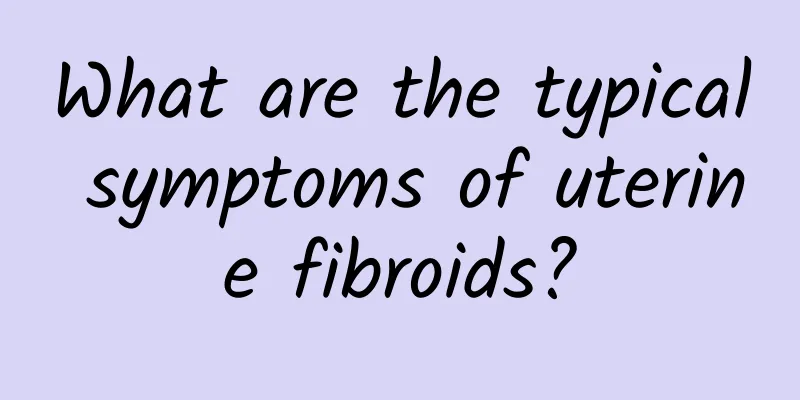What are the typical symptoms of uterine fibroids?

|
Many people may be familiar with uterine fibroids, but they are not very familiar with the typical symptoms of uterine fibroids . What are the typical symptoms of uterine fibroids? Let's talk about the typical symptoms of uterine fibroids. Usually, the typical symptoms of uterine fibroids are as follows: 1. Pain The typical symptoms of this type of uterine fibroids are more common. In addition to the pain caused by compression of the pelvic nerves, the pedunculated submucosal fibroids cause uterine contractions in the uterine cavity and produce pain. When the fibroids block the cervical canal and hinder the outflow of menstrual blood, it can cause dysmenorrhea. When the pedunculated subserosal fibroids are twisted or when the uterine fibroids become red or infected during pregnancy, they can cause more severe abdominal pain. 2. Lower abdominal mass Typical symptoms of uterine fibroids also include when the subserosal or intramural fibroids grow beyond the pelvic cavity, patients can usually feel the mass themselves and go to the hospital for treatment, which may be accompanied by a feeling of falling. 3. Compression symptoms If the fibroids located in the lower part of the uterus and cervix are incarcerated in the pelvic cavity, they can compress the pelvic tissues and nerves, causing pain in the lower abdomen and back pain. If the fibroids grow forward or backward, they can compress the bladder, urethra or rectum, causing frequent urination, dysuria, urinary retention or constipation. When the fibroids grow to both sides, they form broad ligament fibroids, which can compress the ureter and cause hydroureteral or renal pelvis; if they compress the pelvic blood vessels and lymphatic vessels, they can cause lower limb edema. These are typical symptoms of uterine fibroids. 4. Increased menstruation It mostly occurs in submucosal and intramural fibroids. At this time, the typical symptoms of uterine fibroids are menorrhagia, prolonged menstruation or irregular vaginal bleeding. The main reasons for increased bleeding are: the area of the endometrium increases, the endometrium proliferates due to the effect of estrogen, the fibroids hinder the contraction of the uterus, and affect the blood circulation, causing endometrial congestion. Due to long-term bleeding, patients often have varying degrees of anemia. The above is an introduction to the typical symptoms of uterine fibroids. Once the typical symptoms of uterine fibroids appear, you must seek medical attention in time to avoid missing the best time for treatment. For more information, please visit the uterine fibroid disease special topic at http://www..com.cn/fuke/zgjl/ or consult an expert for free. The expert will then give a detailed answer based on the patient's specific situation. |
<<: What are the causes of uterine fibroids?
>>: A brief analysis of surgical treatment methods for uterine fibroids
Recommend
Adolescent patients with functional uterine bleeding should pay attention to regulating their emotions
Dysfunctional uterine bleeding during adolescence...
What should be paid attention to in treating pelvic inflammatory disease
What should I pay attention to when treating pelv...
What are the dangers of endometrial tuberculosis?
Some female friends do not know much about endome...
How to prevent the infection of endometrial tuberculosis
Endometrial tuberculosis is mostly secondary infe...
Brief analysis of the clinical manifestations of chronic cervicitis
Many female friends may be familiar with chronic ...
Can congenital absence of vagina recur?
Can congenital absence of vagina recur? In fact, ...
Tiffany Hsu trains her abdominal muscles by doing 3 yoga "boat pose" variations! The most effective way to train abdominal muscles and vest lines
Tiffany Hsu demonstrates the 3 most effective &qu...
What kind of harm will women suffer after multiple abortions?
Unexpected pregnancy can be solved by abortion in...
Winter is coming with low temperatures, be careful of cardiovascular diseases! Nutritionist Zhang Yizhen: Eat these 5 heart-protecting foods wisely
The winter solstice (December 22) is coming soon....
4 abnormal conditions for early or late menstruation! TCM doctor Cai Guangqian reveals: 6 common causes of menstrual disorders
Due to high work pressure, staying up late, overw...
Eat melons wisely to cool down! Bitter melon, cucumber, and watermelon can lower body temperature and help with bowel movements
The sun is high in the sky in summer, the weather...
The secret to losing fat in 2 months: weight training + squats
Those who have been to Japan have probably seen t...
What are the main sequelae of abortion?
Now many women know that the way to terminate pre...
4 Diet Tips for Losing Weight through Exercise
You have worked out very hard, but your weight re...
What are the most obvious signs before menstruation?
There is no such thing as the "most obvious ...









